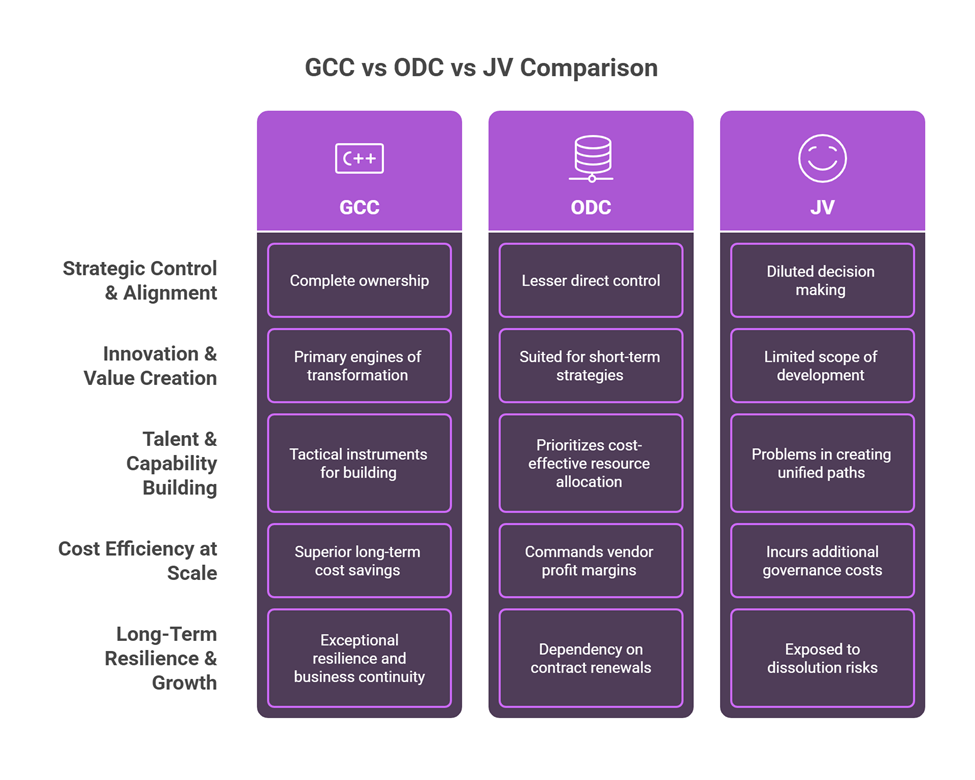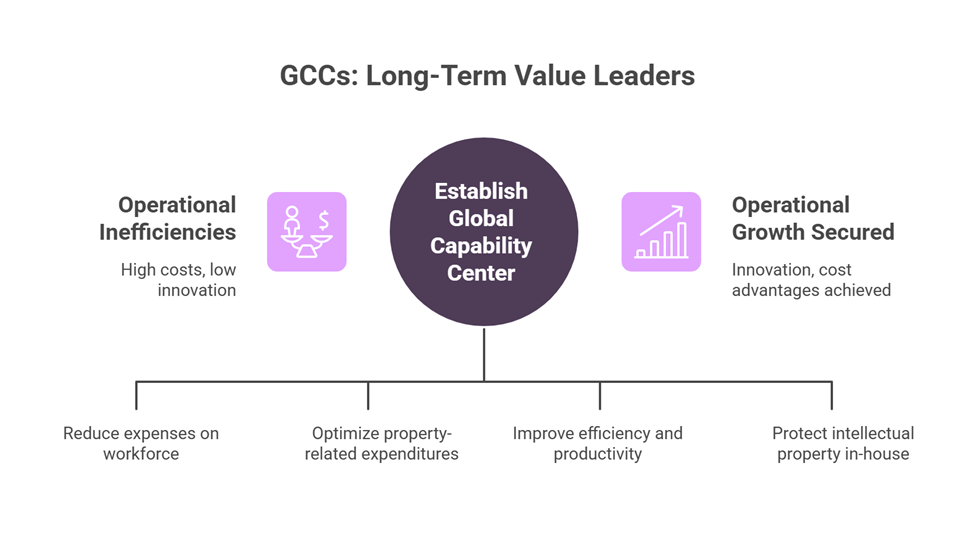Why do MNCs prefer GCCs over ODC and JVs?
- Home
- Blog Details

- August 17 2025
- Pankaj Singh
A Global Capability Center (GCC) is not a simple cost center but a strategic asset. It serves as an integrated hub for innovation and end-to-end business processes, with maximum control over talent management, operations, and intellectual property. The system is today’s preferred model for organizations seeking to build long-term, high-value capabilities.
Table of Contents
ToggleWhat are the ODC and JV models?
The Offshore Development Center (ODC) represents an agile, technically focused model. It can be termed as a dedicated, remote extension of a company’s cores teams, providing rapid access to specialized technical talent and accelerating project deliveries. It ensures a higher degree of control and integration than traditional outsourcing, helping organizations scale development capacity in a quick and cost-effective manner.
A Joint Venture (JV) is a strategic partnership, used for mitigating risks while entering a new market as part of large-scale, capital-intensive projects. By establishing a new legal entity with a local partner, businesses share costs and risks while leveraging complementary assets, market knowledge, and regulatory expertise. It is a powerful tool to circumnavigate foreign market complexities where local presence is a prerequisite for success.
How Can GCCs Outperform ODCs And JVs For Capability Expansion?
GCC vs ODC vs JV
- Strategic Control & Alignment:
The GCC model’s foundation is complete ownership, which provides unparalleled control over operations, data, and intellectual property. This direct oversight is critical for navigating complex global regulatory landscapes. It also certifies deep alignment with corporate strategy and culture, a stark contrast to the transactional nature of traditional outsourcing.
An ODC model leads to lesser direct control as well as weaker corporate alignment, with higher data security and IP risk. In a JV, the decision making can be diluted due to joint control, possibly impacting strategic focus.
- Innovation & Value Creation:
GCCs have become the primary engines of transformation for many multinational organizations. Without the constraints of third-party SLAs, in-house teams own business outcomes, promoting a culture of experimentation and end-to-end product development. According to Zinnov, nearly 86% of GCCs in India are now actively involved in AI and machine learning projects, with many leading the worldwide AI deployment of their parent companies.
ODCs are more suited for short to mid-term strategies, where innovation is project-focused or just requires high-volume tech output. Under JVs, the scope of development is limited as per the terms of partnership along with IP sharing challenges.
- Talent & Capability Building:
Besides accessing substantial talent pools, GCCs are tactical instruments for building and retaining human capital. They enable direct recruitment of high-quality, specialized talent with a better cultural fit. The Build-Operate-Transfer model GCC provides a strong foundation for a company’s long-term development goals.
ODCs typically prioritize cost-effective resource allocation over talent development, while JVs may face problems in creating unified career progression paths and cultural integration due to competing organizational loyalties.
- Cost Efficiency at Scale:
To deliver superior long-term cost savings in large-scale operations, a GCC can eliminate vendor margins and power deep process optimization. Despite high upfront investments, the long-term ROI obtain via considerable efficiency and value creation, is significantly greater than that of alternatives. For instance, GCCs can result in 30 to 45% cost savings on HR and payroll functions and up to 40% savings on real estate.
ODCs command vendor profit margins and may lack incentives for long-term process optimization, whereas JVs incur additional governance costs and profit-sharing arrangements that reduce overall cost efficiency.
- Long-Term Resilience & Growth:
Global Capability Centers demonstrated exceptional resilience and robust business continuity throughout the COVID-19 crisis. They shielded companies from external vendor risks and extended highly scalable operations. Opting for GCC services is an essential way to future-proof and sustainable a global enterprise.
With dependency on contract renewals and external vendor stability, ODCs can cause business disruptions, while JVs are exposed to dissolution risks from partner conflicts and misaligned long-term objectives.

Why Global Capability Centers (GCCs) Are the Long-Term Value Leader?
For enterprises aiming to secure operational growth, maximize innovation, and achieve significant cost advantages while maintaining security and agility – GCCs present a resilient, scalable, and competitive foundation. Key factors contributing to long-term savings include lower labor costs, real estate savings, and streamlined process efficiencies.
Under full ownership, control, and complete oversight, GCCs empower leadership to navigate complex regulatory frameworks, safeguard intellectual property, and foster deep alignment with corporate objectives. With a Global Capability Center, intellectual property and sensitive data are more secure in-house, due to direct company governance. The approach significantly cuts down the risks associated with third-party vendors, protecting critical information.

Pankaj Singh has extensive experience in market research and content creation within the industrial sector. He currently writes insightful articles related to business, manufacturing, technology, and automation for Prescient Technologies.
- Pankaj Singhhttps://www.pre-scient.com/author/srvprescient/
- Pankaj Singhhttps://www.pre-scient.com/author/srvprescient/
- Pankaj Singhhttps://www.pre-scient.com/author/srvprescient/
- Pankaj Singhhttps://www.pre-scient.com/author/srvprescient/


